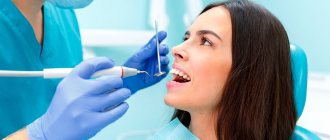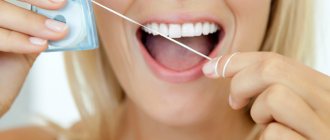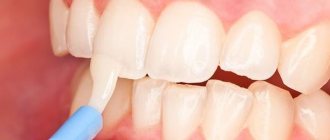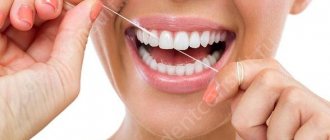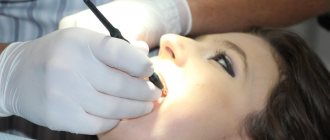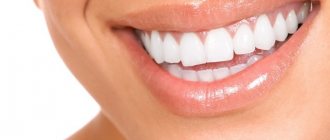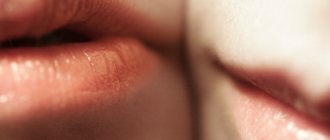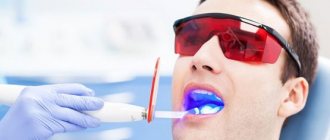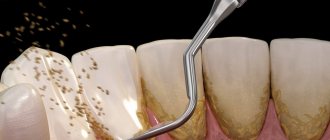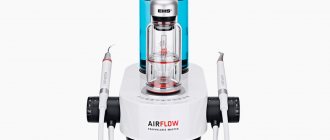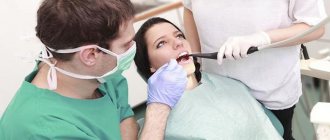Why brush your teeth?
One of the dirtiest places in our body is the oral cavity. This is due to high humidity and food intake - good conditions for the proliferation of hundreds of microorganisms. Our defense mechanisms cope with pathogenic and opportunistic microflora, and the oral cavity remains healthy. We help our own immunity by taking care of our oral cavity.
If you don't brush your teeth for a long time or do it incorrectly, bacteria multiply faster. A soft bacterial plaque forms. Microorganisms secrete a large amount of acids that destroy the enamel - this is how caries appears.
The soft plaque gradually mineralizes, and it becomes impossible to remove it with a toothbrush. Tartar appears - dense formations are usually located near the cervical area of the teeth, between the teeth, on the inside of the incisors. The presence of tartar increases the risk of developing various oral diseases:
- the sharp edges of hard plaque injure the gums, which causes inflammatory gum diseases - gingivitis, periodontitis;
- the formation of subgingival stone leads to periodontal disease - the gum literally peels off from the surface of the tooth, forming a periodontal pocket;
- The proliferation of bacteria leads to halitosis, an unpleasant odor from the mouth that cannot be eliminated with perfumed mouthwashes.
Plaque, food particles remaining between the teeth, increase the chances of developing caries and increase the risk of complications: pulpitis, periodontitis, cysts, granulomas, etc. Information on how to clean your teeth will help prevent many diseases.
Ask a Question
Features of professional cleaning
Modern methods of removing tartar are a safe and comfortable procedure. Even pregnant women can undergo professional cleaning.
Teeth brushing is a virtually painless procedure; in very rare cases, the patient is given application anesthesia. Removal of tartar and plaque is carried out in several stages:
- Stone removal.
The main stage of professional teeth cleaning is the removal of tartar under the influence of ultrasound. The stone easily comes off the surface of the teeth and is cleaned off. - Cleaning using an Air Flow device.
Under pressure, abrasive particles are delivered to the tooth surface from a special apparatus with a stream of water. The particles not only clean, but also whiten the enamel, making it 1-2 shades brighter. - Polishing of hard tooth tissues.
After brushing, the surface of the enamel becomes slightly rough, and if left in this condition, tartar will very quickly begin to form on the surface of the teeth. To prevent this from happening, teeth are treated using special rubber discs and brushes. After polishing, the enamel becomes smooth, which protects it from negative influences. - Antiseptic treatment.
Prevention of periodontal inflammation during professional teeth cleaning is antiseptic treatment of the oral cavity. The use of antiseptics will stop the spread of infection and avoid additional complications. - Fluoridation of teeth.
This stage of treatment is mandatory if the patient's enamel is weak, sensitive and prone to destruction. After cleaning, fluoride varnish is applied to the teeth, which helps strengthen the enamel. - Use of medicinal dressings.
In case of severe periodontal inflammation, bleeding or significant trauma to the gums that occurred during the removal of dental plaque, the doctor may decide to use therapeutic dressings. Dressings are prepared before use and may contain antibiotics, antiviral drugs, enzymes, antiseptics or sulfonamides.
How to brush your teeth correctly?
You need to brush your teeth twice a day: in the morning and before bed. Doctors recommend spending at least three minutes on each hygiene procedure. Sweeping movements should be directed from the gums to the edge of the crown. You should not move the brush up and down without lifting it from the surface of your teeth.
In addition to cleaning the surfaces of the teeth with a brush, you need to pay attention to the condition of the interdental spaces. Food debris gets stuck in them and plaque forms faster. Using dental floss will help remove them. The floss is carefully inserted between the teeth, leaving behind soft plaque and food debris. You also need to pay attention to the surface of the tongue and the inner surface of the cheeks - many models of brushes have an element on the back side for cleansing the mucous membranes.
You need to finish brushing your teeth with a mouthwash: you can make the solution yourself or buy it at a pharmacy. Without indications, it is better not to use antiseptics, alcohol-based or chlorhexidine-based products; a regular product for daily hygiene is sufficient. You need to rinse your mouth for about 30 seconds.
It is important to brush your teeth after every meal. Cleaning them during the day can be problematic, so people with a healthy oral cavity can use chewing gum: chew it for no more than five minutes and only after eating. Everyone else needs to use mouth rinses.
Even strict adherence to the rules of brushing your teeth does not guarantee impeccable cleanliness. Removal of pigmented plaque and tartar is carried out in a dental office. Two visits per year to a dental hygienist are usually sufficient. If plaque forms faster, you wear braces or other dental structures, it is advisable to undergo professional cleaning up to 3 times a year.
Enamel sensitivity
May increase in the first days after professional hygiene. At first, to avoid pain, it is better not to consume sour or very sweet foods and drinks. It is not recommended to consume cold and hot at the same time or too cold, hot drinks and foods. This is dangerous not only by increasing the sensitivity of the enamel, but also by weakening it and the appearance of microcracks on its surface.
To prevent enamel sensitivity from increasing after professional cleaning, it is better to complete the procedure with remineralization or fluoridation. This will strengthen the enamel and remove discomfort.
If the enamel is weakened, after cleaning, the doctor may additionally prescribe special products, toothpastes, to strengthen it.
If severe pain persists after the procedure or the pain does not decrease within several days, you should consult a dentist.
How to use thread?
We devoted a separate section to the use of dental floss, or floss, since many patients ignore this hygiene product or do not know how to use it correctly.
You need to take a thread about 45 cm long and wind most of it around your middle fingers. To clean, it is enough to leave a thread 2-3 cm long. Holding the thread between your thumbs and forefingers, carefully place it between your teeth and move it up and down. Then pay attention to the base of the tooth, making sure that the thread penetrates under the cervical part of the gum. Movements must be gentle to prevent damage to the gums. To remove the thread, lift it and move it back and forth.
Use a clean section of floss as you move from tooth to tooth. For the second jaw you need to take a new thread.
How to choose pasta?
Toothpaste is selected individually depending on the condition of the oral cavity and existing problems. For people with increased tooth sensitivity, there are special toothpastes that reduce hyperesthesia. The components of the product “seal” the dentinal tubules and help reduce dental reactions.
Pastes with antibacterial components may be suitable for people who quickly develop plaque and recur inflammatory tissue diseases.
If your gums are bleeding, your choice may be a paste with ingredients that strengthen soft tissue.
It is important to pay attention to the mineral composition of the product: the presence of fluoride, calcium, magnesium, etc. This is especially true for people with demineralized enamel. It is better to consult a doctor to choose the right paste.
Many people strive to make their teeth enamel lighter and choose whitening toothpastes. Some of them contain enzymes that help remove plaque easily. This does not directly affect the color of the tooth, but removing plaque allows you to “expose” the enamel, visually it will look lighter. Such pastes are relatively harmless, but it is better to use them no longer than 4-8 weeks.
The second group of whitening pastes are highly abrasive: they contain large abrasive particles that are designed to remove pigmented plaque. You cannot use them constantly: this can cause micro-scratches of the enamel and increase the risk of tooth destruction by caries. To obtain the desired effect without harm to health, it is enough to use the paste 1-2 times a week.
Products harmful to enamel
What foods are the most beneficial for teeth? Those containing calcium and fluorine. They protect and remineralize the enamel, that is, they replenish those microelements that it loses under the influence of acids that are present in the oral cavity. These foods include nuts, chicken and cheese.
It is beneficial to eat solid vegetables and fruits. The high water content weakens the destructive effect of the sugars that are present in these products. They also stimulate the production of saliva, which prevents the formation of tooth decay.
Due to their high acid content, tomatoes and citrus fruits are not advisable to eat as a snack. Eating large amounts of foods containing starch and sugar is also harmful.
Among drinks, it is advisable to give preference to plain water, milk and tea without sugar.
How to choose a regular brush?
The choice of toothbrush should be agreed with the dentist. Brushes are divided into three types depending on the degree of stiffness of the bristles: soft, medium and hard.
Soft ones are used for diseases of periodontal tissues and mucous membranes of the oral cavity: gingivitis, stomatitis, candidiasis, periodontitis, glossitis, bleeding gums of unknown origin, etc. Usually this is a temporary measure so as not to injure the tissues during acute inflammation. Soft bristles cannot fully cope with cleansing. Such brushes are used on an ongoing basis by patients with pathologies, underdevelopment of enamel, as well as second and third degree periodontal disease.
Brushes with medium bristles are recommended for most patients. They can be used in the presence of orthopedic structures, implants, fillings, veneers. It does a good job of removing soft plaque and food debris.
Hard bristles can damage the enamel and delicate tissues of the mucous membranes and gums. Its use has a number of indications. The dentist may recommend this brush to smokers and coffee and black tea drinkers. It is also advisable to use it in cases where plaque forms quickly. However, there are several conditions that allow you to use a hard brush: the enamel must be strong, of normal thickness, and the gums must be strong, without signs of disease.
There are also special brushes: super-hard ones for bridges and removable structures, brushes for patients with braces, etc. The doctor will select a brush taking into account individual characteristics.
Why does my breath smell even after brushing my teeth?
An unpleasant odor in most cases appears when hard and soft deposits accumulate in the interdental spaces. Therefore, the main reason for its persistence after ultrasound remains poor cleaning of the oral cavity. Most often, dentists do not clean the subgingival space well enough. In this situation, periodontal pockets accumulate plaque and periodontitis or periodontal disease develops.
If the patient is absolutely healthy, the following factors can lead to halitosis:
- Poor hygiene. If a person continues to use a brush with paste irregularly, the effect of professional cleansing will quickly disappear.
- Insufficient cleanliness of removable structures after prosthetics.
- Including foods that have a strong smell in your diet. This includes onions, garlic, canned fish, etc.
- Inflammatory processes, extensive carious lesions, neoplasms (cysts).
- Problems with the gastrointestinal tract (gastritis, peptic ulcer), liver, kidneys.
- Chronic diseases of the upper respiratory tract (tonsillitis, sinusitis).
- Diabetes mellitus (acetone smell is noticeable from the mouth).
- Drug therapy using certain drugs (antibacterial agents, antidepressants, allergy medications and high or low blood pressure).
- Pathological dryness of mucous membranes. The mouth does not produce enough saliva. It is needed not only for moisturizing soft and hard tissues, but also for removing pathogenic agents (bacteria, microbes) and regeneration.
If the stench persists after ultrasonic cleaning, it is recommended to visit a doctor. A dentist and other specialized specialists will be needed to establish the exact causes of this phenomenon and develop further therapeutic tactics.
Brushing your teeth with an electric brush
Electric toothbrushes vibrate and/or rotate to effectively remove plaque and provide a cleaner mouth. If you are wondering what is better to brush your teeth - a regular or an electric brush - then you should give preference to the latter.
But it is important to strictly follow the cleaning rules so that the daily hygiene procedure is effective and safe. We have prepared a small instruction:
- squeeze the paste onto the brush and press the power button;
- hold the brush at a 45 degree angle;
- Move the brush along the front surface of your teeth, pausing for a few seconds on each one. Typically the head size is sufficient to clean one tooth;
- repeat the manipulations along the inner surface of the teeth;
- complete the procedure by cleaning the chewing surfaces of the teeth.
Important: there is no need to put extra effort or pressure on the brush. Direct it, and the movable head will handle the task itself. Some models of electric brushes are equipped with pressure sensors and will warn you if there is excessive pressure.
Recommendations for what you can eat after professional teeth cleaning at the dentist
The procedure is safe and does not lead to negative consequences. However, hard and soft tissues are still injured to varying degrees. During the first few weeks, the enamel and gums are especially sensitive and require special care. Despite the fact that ultrasound is considered the most advanced and effective method, complications may arise in the form of inflammation and increased susceptibility to external influences.
Pro Tips:
- if the pain does not go away for a long time, painkillers do not help, then you need to urgently visit the dental clinic;
- To relieve the inflammatory process, pharmaceutical gels and ointments are used;
- it is important to monitor the nutrition and temperature of food and drinks;
- It's worth buying a suitable brush and paste.
